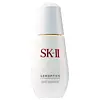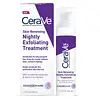What's inside
What's inside
 Key Ingredients
Key Ingredients

 Benefits
Benefits

 Concerns
Concerns

 Ingredients Side-by-side
Ingredients Side-by-side

Water
Skin ConditioningGalactomyces Ferment Filtrate
HumectantButylene Glycol
HumectantCyclopentasiloxane
EmollientNiacinamide
SmoothingTriethylhexanoin
MaskingGlycerin
HumectantPentylene Glycol
Skin ConditioningNylon-12
Phytosteryl/Octyldodecyl Lauroyl Glutamate
Skin ConditioningInositol
HumectantPolymethylsilsesquioxane
Boron Nitride
AbsorbentCaprylic/Capric Triglyceride
MaskingPanthenol
Skin ConditioningPEG-20 Sorbitan Cocoate
EmulsifyingDimethicone/Vinyl Dimethicone Crosspolymer
Skin ConditioningAcrylates/C10-30 Alkyl Acrylate Crosspolymer
Emulsion StabilisingPhenoxyethanol
PreservativePEG-11 Methyl Ether Dimethicone
EmulsifyingPolyacrylamide
Laureth-7
EmulsifyingBenzyl Alcohol
PerfumingAminomethyl Propanol
BufferingC13-14 Isoparaffin
EmollientDisodium EDTA
Methylparaben
PreservativeHexyldecanol
EmollientSodium Benzoate
MaskingXanthan Gum
EmulsifyingAscorbyl Glucoside
AntioxidantLaminaria Saccharina Extract
Skin ProtectingTocopherol
AntioxidantZea Mays Oil
EmulsifyingMethicone
EmollientCI 77492
Cosmetic ColorantCI 75130
Cosmetic ColorantWater, Galactomyces Ferment Filtrate, Butylene Glycol, Cyclopentasiloxane, Niacinamide, Triethylhexanoin, Glycerin, Pentylene Glycol, Nylon-12, Phytosteryl/Octyldodecyl Lauroyl Glutamate, Inositol, Polymethylsilsesquioxane, Boron Nitride, Caprylic/Capric Triglyceride, Panthenol, PEG-20 Sorbitan Cocoate, Dimethicone/Vinyl Dimethicone Crosspolymer, Acrylates/C10-30 Alkyl Acrylate Crosspolymer, Phenoxyethanol, PEG-11 Methyl Ether Dimethicone, Polyacrylamide, Laureth-7, Benzyl Alcohol, Aminomethyl Propanol, C13-14 Isoparaffin, Disodium EDTA, Methylparaben, Hexyldecanol, Sodium Benzoate, Xanthan Gum, Ascorbyl Glucoside, Laminaria Saccharina Extract, Tocopherol, Zea Mays Oil, Methicone, CI 77492, CI 75130
Water
Skin ConditioningGlycerin
HumectantCetearyl Ethylhexanoate
EmollientCetearyl Alcohol
EmollientDimethicone
EmollientGlycolic Acid
BufferingLactic Acid
BufferingSodium Hydroxide
BufferingDipotassium Glycyrrhizate
HumectantPolyacrylate Crosspolymer-6
Emulsion StabilisingCeramide NP
Skin ConditioningCeramide AP
Skin ConditioningCeramide EOP
Skin ConditioningCarbomer
Emulsion StabilisingCetearyl Glucoside
EmulsifyingBehentrimonium Methosulfate
Triethyl Citrate
MaskingSodium Hyaluronate
HumectantSodium Lauroyl Lactylate
EmulsifyingCholesterol
EmollientPhenoxyethanol
PreservativePhenylethyl Resorcinol
AntioxidantIsopropyl Myristate
EmollientCaprylyl Glycol
EmollientCitric Acid
BufferingTrisodium Ethylenediamine Disuccinate
Xanthan Gum
EmulsifyingPhytosphingosine
Skin ConditioningBenzoic Acid
MaskingWater, Glycerin, Cetearyl Ethylhexanoate, Cetearyl Alcohol, Dimethicone, Glycolic Acid, Lactic Acid, Sodium Hydroxide, Dipotassium Glycyrrhizate, Polyacrylate Crosspolymer-6, Ceramide NP, Ceramide AP, Ceramide EOP, Carbomer, Cetearyl Glucoside, Behentrimonium Methosulfate, Triethyl Citrate, Sodium Hyaluronate, Sodium Lauroyl Lactylate, Cholesterol, Phenoxyethanol, Phenylethyl Resorcinol, Isopropyl Myristate, Caprylyl Glycol, Citric Acid, Trisodium Ethylenediamine Disuccinate, Xanthan Gum, Phytosphingosine, Benzoic Acid
 Reviews
Reviews

Ingredients Explained
These ingredients are found in both products.
Ingredients higher up in an ingredient list are typically present in a larger amount.
Glycerin is already naturally found in your skin. It helps moisturize and protect your skin.
A study from 2016 found glycerin to be more effective as a humectant than AHAs and hyaluronic acid.
As a humectant, it helps the skin stay hydrated by pulling moisture to your skin. The low molecular weight of glycerin allows it to pull moisture into the deeper layers of your skin.
Hydrated skin improves your skin barrier; Your skin barrier helps protect against irritants and bacteria.
Glycerin has also been found to have antimicrobial and antiviral properties. Due to these properties, glycerin is often used in wound and burn treatments.
In cosmetics, glycerin is usually derived from plants such as soybean or palm. However, it can also be sourced from animals, such as tallow or animal fat.
This ingredient is organic, colorless, odorless, and non-toxic.
Glycerin is the name for this ingredient in American English. British English uses Glycerol/Glycerine.
Learn more about GlycerinPhenoxyethanol is a preservative that has germicide, antimicrobial, and aromatic properties. Studies show that phenoxyethanol can prevent microbial growth. By itself, it has a scent that is similar to that of a rose.
It's often used in formulations along with Caprylyl Glycol to preserve the shelf life of products.
Water. It's the most common cosmetic ingredient of all. You'll usually see it at the top of ingredient lists, meaning that it makes up the largest part of the product.
So why is it so popular? Water most often acts as a solvent - this means that it helps dissolve other ingredients into the formulation.
You'll also recognize water as that liquid we all need to stay alive. If you see this, drink a glass of water. Stay hydrated!
Learn more about WaterXanthan gum is used as a stabilizer and thickener within cosmetic products. It helps give products a sticky, thick feeling - preventing them from being too runny.
On the technical side of things, xanthan gum is a polysaccharide - a combination consisting of multiple sugar molecules bonded together.
Xanthan gum is a pretty common and great ingredient. It is a natural, non-toxic, non-irritating ingredient that is also commonly used in food products.
Learn more about Xanthan Gum